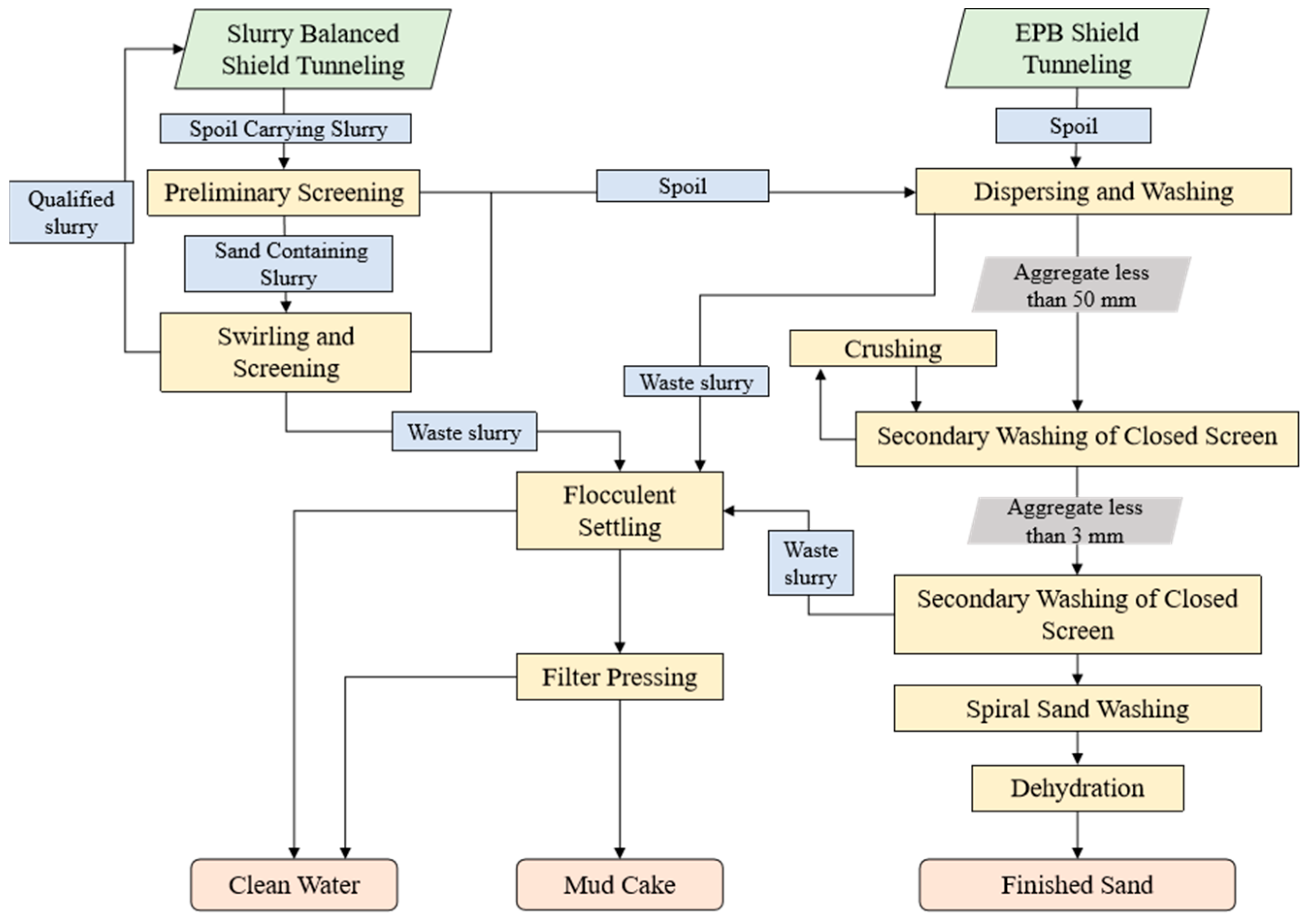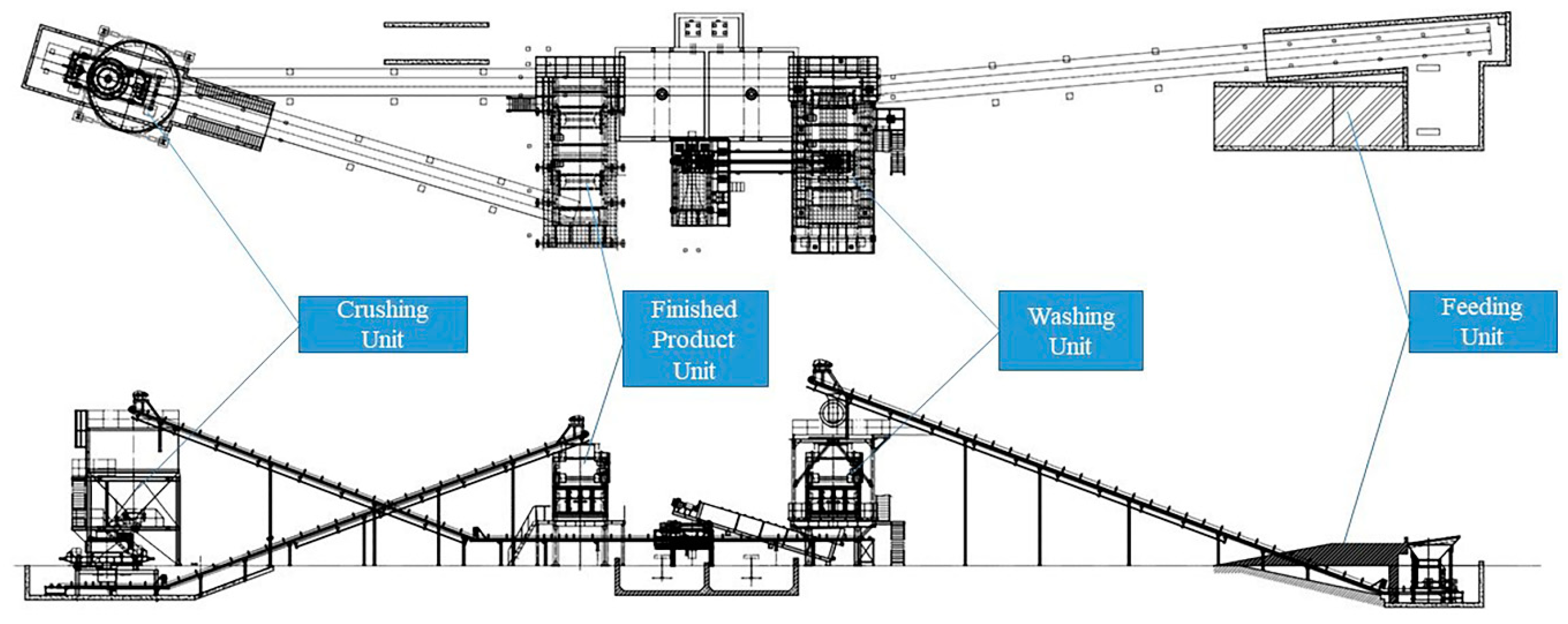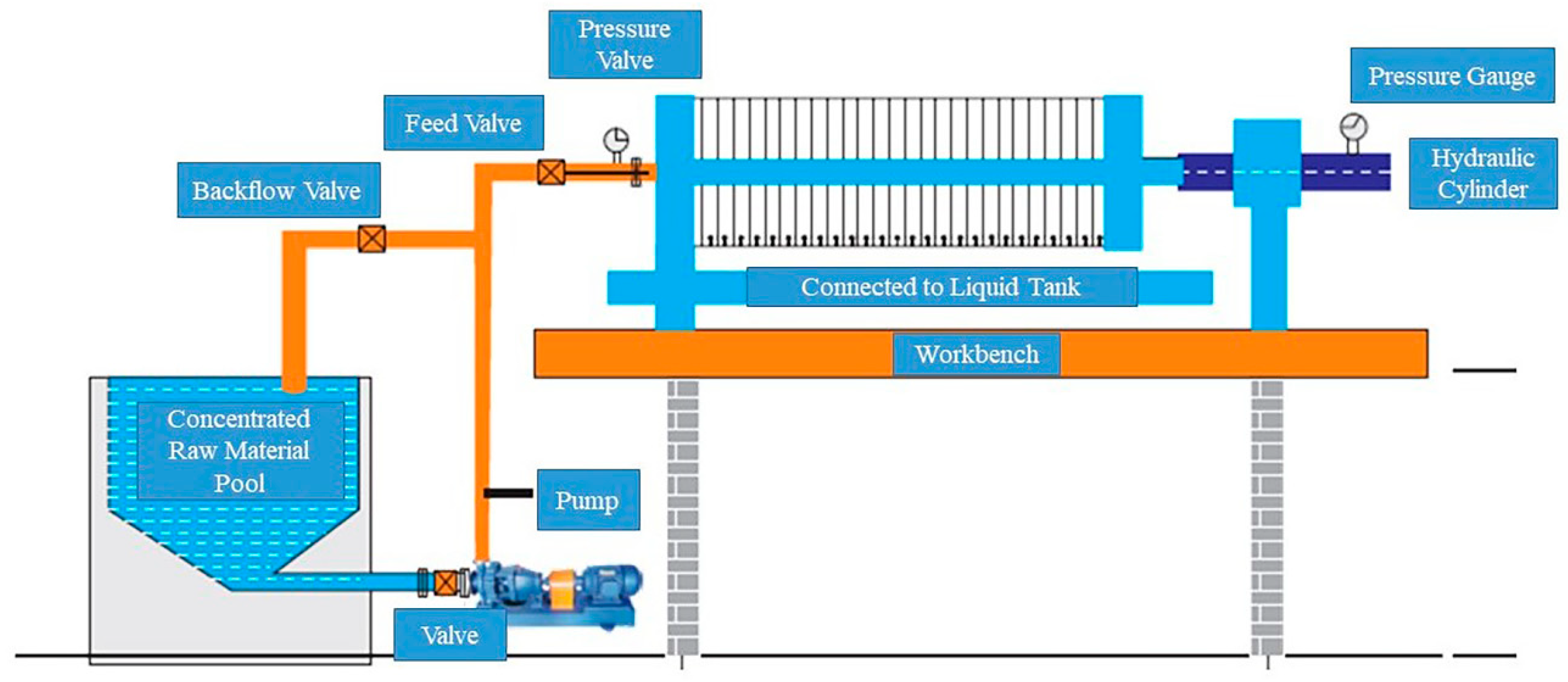Study on Resourceful Treatment and Carbon Reduction Intensity of Metro Shield Slag: An Example of a Tunnel Interval of Shenzhen Line 13
Abstract
:1. Introduction
2. Research Methods
2.1. Metro Shield Sludge Integrated Recycling Technology
2.2. Case Background Introduction
2.3. Information on Main Materials and Equipment Parameters
2.4. Data Collection and Processing
3. Results
3.1. Detailed Recycling Process
3.1.1. Preliminary Slurry Screening
3.1.2. Slurry Swirling and Screening
3.1.3. Dispersing and Washing
3.1.4. Secondary Washing of Closed Screen
3.1.5. Crushing
3.1.6. Spiral Sand Washing
3.1.7. Dehydration
3.1.8. Flocculent Settling
3.1.9. Filter Pressing
3.2. Economic and Environmental Analysis
4. Discussion
5. Conclusions
Author Contributions
Funding
Institutional Review Board Statement
Informed Consent Statement
Data Availability Statement
Acknowledgments
Conflicts of Interest
References
- Yu, C.; Zhou, A.N.; Chen, J.; Arulrajah, A.; Horpibulsuk, S. Analysis of a tunnel failure caused by leakage of the shield tail seal system. Undergr. Space 2020, 5, 105–114. [Google Scholar] [CrossRef]
- Massoudinejad, M.; Amanidaz, N.; Santos, R.M.; Bakhshoodeh, R. Use of municipal, agricultural, industrial, construction and demolition waste in thermal and sound building insulation materials: A review article. J. Environ. Health Sci. Eng 2019, 17, 1227–1242. [Google Scholar] [CrossRef] [PubMed]
- Zhang, Y.J.; Tan, W.L. Demolition waste recycling in China: New evidence from a demolition project for highway development. Waste Manag. Res. 2020, 38, 696–702. [Google Scholar] [CrossRef] [PubMed]
- Yu, Z.H.; Yang, D.Y.; Zhang, D.W.; Feng, S. Application of green treatment and reuse technology of shield. Hazard Control Tunn. Undergr. Eng. 2022, 4, 100–106. [Google Scholar]
- Zhang, C.; Chen, K.; Yang, J.S.; Fu, J.Y.; Wang, S.Y.; Xie, Y.P. Reuse of discharged soil from slurry shield tunnel construction as synchronous grouting material. J. Constr. Eng. Manag. 2022, 148, 04021193. [Google Scholar] [CrossRef]
- Chen, R.; Yang, K.; Xiao, W.; Gao, D.H.; Ren, F.M. Analysis on recycling treatment and disposal of engineering slag. Environ. Eng. 2020, 38, 22–26. [Google Scholar] [CrossRef]
- Tanner, S.; Katra, I.; Argaman, E.; Ben-Hur, M. Erodibility of waste (Loess) soils from construction sites underwater and wind erosional forces. Sci. Total Environ. 2018, 616, 1524–1532. [Google Scholar] [CrossRef]
- Yin, Y.P.; Li, B.; Wang, W.P.; Zhan, L.T.; Xue, Q.; Gao, Y.; Zhang, N.; Chen, H.Q.; Liu, T.K.; Li, A.G. Mechanism of the december 2015 catastrophic landslide at the Shenzhen landfill andcontrolling geotechnical risks of urbanization. Engineering 2016, 2, 230–249. [Google Scholar] [CrossRef]
- Xing, J.; Zhen, T.; Hang, Y.U.; Zheng, Y. Technology and management innovation of the first-of-a-kind (FOAK) demonstration project—HPR1000. Front. Eng. Manag. 2021, 8, 471–475. [Google Scholar] [CrossRef]
- Yu, B.; Wang, J.; Li, J.; Lu, W.; Li, C.Z.; Xu, X. Quantifying the potential of recycling demolition waste generated from urban renewal: A case study in Shenzhen, China. J. Clean. Prod. 2020, 247, 119127. [Google Scholar] [CrossRef]
- Weerasinghe, U. Sustainable buildings: Evolution beyond building environmental assessment methods. J. Green Build. 2022, 17, 199–217. [Google Scholar] [CrossRef]
- Xie, R.; Fang, J.Y.; Liu, C.J. The effects of transportation infrastructure on urban carbon emissions. Appl. Energy 2017, 196, 199–207. [Google Scholar] [CrossRef]
- Hu, W.; Dong, J.; Ren, R.; Chen, Z. Underground logistics systems: Development overview and new prospects in China. Front. Eng. Manag. 2023, 10, 354–359. [Google Scholar] [CrossRef]
- Zhang, N.; Duan, H.B.; Sun, P.W.; Li, J.B.; Zuo, J.; Mao, R.C.; Liu, G.; Niu, Y.N. Characterizing the generation and environmental impacts of subway-related excavated soil and rock in China. J. Clean. Prod. 2020, 248, 119242. [Google Scholar] [CrossRef]
- Magnusson, S.; Lundberg, K.; Svedberg, B.; Knutsson, S. Sustainable management of excavated soil and rock in urban areas—A literature review. J. Clean. Prod. 2015, 93, 18–25. [Google Scholar] [CrossRef]
- Huang, T.; Kou, S.C.; Liu, D.Y.; Li, D.W.; Xing, F. Evaluation of the techno-economic feasibility for excavated soil recycling in Shenzhen, China. Sustainability 2022, 14, 3028. [Google Scholar] [CrossRef]
- Ghisellini, P.; Ripa, M.; Ulgiati, S. Exploring environmental and economic costs and benefits of a circular economy approach to the construction and demolition sector. A literature review. J. Clean. Prod. 2018, 178, 618–643. [Google Scholar] [CrossRef]
- Hoang, N.H.; Ishigaki, T.; Kubota, R.; Tong, T.K.; Nguyen, T.T.; Nguyen, H.G.; Yamada, M.; Kawamoto, K. Financial and economic evaluation of construction and demolition waste recycling in Hanoi, Vietnam. Waste Manag. 2021, 131, 294–304. [Google Scholar] [CrossRef]
- Islam, R.; Nazifa, T.H.; Yuniarto, A.; Uddin, A.S.M.S.; Salmiati, S.; Shahid, S. An empirical study of construction and demolition waste generation and implication of recycling. Waste Manag. 2019, 95, 10–21. [Google Scholar] [CrossRef]
- Oggeri, C.; Fenoglio, T.M.; Vinai, R. Tunnel spoil classification and applicability of lime addition in weak formations for muck reuse. Tunn. Undergr. Space Technol. 2014, 44, 97–107. [Google Scholar] [CrossRef]
- Fei, J.; Jie, Y.; Xiong, H.; Wu, Z. Granular roll waves along a long chute: From formation to collapse. Powder Technol. 2021, 377, 553–564. [Google Scholar] [CrossRef]
- Fei, J.B.; Jie, Y.X.; Sun, X.H.; Xiong, H. Physical interpretation of shear-rate behaviour of soils and geotechnical solution to the coefficient of start-up friction with low inertial number. Sci. Rep. 2020, 10, 12162. [Google Scholar] [CrossRef]
- Li, J.; Liang, J.; Zuo, J.; Guo, H. Environmental impact assessment of mobile recycling of demolition waste in Shenzhen, China. J. Clean. Prod. 2020, 263, 121371. [Google Scholar] [CrossRef]
- Fort, J.; Cerny, R. Transition to circular economy in the construction industry: Environmental aspects of waste brick recycling scenarios. Waste Manag. 2020, 118, 510–520. [Google Scholar] [CrossRef] [PubMed]
- Rondinel-Oviedo, D.R. Construction and demolition waste management in developing countries: A diagnosis from 265 construction sites in the Lima Metropolitan Area. Int. J. Constr. Manag. 2023, 23, 371–382. [Google Scholar] [CrossRef]
- Yang, Z.; He, Z.; Liu, Y.; Chen, P.; Li, D. Recycle Application of the Shield Waste Slurry in Backfill Grouting Material: A Case Study of a Slurry Shield Tunnelling in the River-crossing Fuzhou Metro. Mod. Tunn. Technol. 2019, 56, 192–199, 205. [Google Scholar]
- Voit, K.; Kuschel, E. Rock material recycling in tunnel engineering. Appl. Sci. 2020, 10, 2722. [Google Scholar] [CrossRef]
- Lieb, R. Materialbewirtschaftung am Gotthard-Basistunnel—Erkenntnisse aus 15 Jahren Ausführung. [Materials management at the gotthard base tunnel—Experience from 15 years of construction]. Geomech. Tunn. 2009, 2, 619–626. [Google Scholar] [CrossRef]
- Du, L.; Feng, Y.; Lu, W.; Kong, L.; Yang, Z. Evolutionary game analysis of stakeholders’ decision-making behaviours in construction and demolition waste management. Environ. Impact Assess. Rev. 2020, 84, 106408. [Google Scholar] [CrossRef]
- Bao, Z.K.; Lu, W.S.; Peng, Z.Y.; Ng, S.T. Balancing economic development and construction waste management in emerging economies: A longitudinal case study of Shenzhen, China guided by the environmental Kuznets curve. J. Clean. Prod. 2023, 396, 136547. [Google Scholar] [CrossRef]
- Zhang, Y.J.; Liu, J.Y. Overview of research on carbon information disclosure. Front. Eng. Manag. 2020, 7, 47–62. [Google Scholar] [CrossRef]
- Wang, Y.; Wang, G.B.; Li, H.; Gong, L.L.; Wu, Z.Z. Mapping and analyzing the construction noise pollution in China using social media platforms. Environ. Impact Assess. Rev. 2022, 97, 106863. [Google Scholar] [CrossRef]
- Zhou, S.; Li, X.; Ji, C.; Xiao, J. Back-fill grout experimental test for discharged soils reuse of the large-diameter size slurry shield tunnel. KSCE J. Civ. Eng. 2017, 21, 725–733. [Google Scholar] [CrossRef]
- Liu, J.; Wang, X.X.; She, N.; Wu, L.Y.; Bu, Z.W. An ecological sediment treatment technology based on zero emission and 4R concept. In Proceedings of the 5th International Conference on Water Resource and Environment (WRE)/1st International Conference on Advances in Civil and Ecological Engineering Research (ACEER), Macau, China, 16–19 June 2019; Macau University of Science and Technology: Macao, China, 2019. [Google Scholar]






| Type of Energy | Carbon Content per Unit Calorific Value/(t C/TJ) | Carbon Oxidation Rate/% | Carbon Emission Factor/ (kg CO2e/Unit) |
|---|---|---|---|
| Petrol | 20.2 | 0.98 | 3.10 |
| Diesel | 18.9 | 0.98 | 2.93 |
| Electrical power | / | / | 0.89~0.81 |
| Number | Cost | Item | Quantities | Cost of Recycling | Cost of Convention Disposal |
|---|---|---|---|---|---|
| 1 | Construction and Installation | Equipment foundation | 18,000 m2 | ¥4,320,000 | 0 |
| Procurement and Installation | 1 set of sand washing system; 3 filter presses | ¥13,700,000 | 0 | ||
| Supporting Facilities | Closed plant; Pipeline transmission system; Belt conveyor system | ¥2,000,000 | 0 | ||
| 2 | Production and Operation | Labor | 30 people/month, 16 months | ¥3,840,000 | 0 |
| Water and Electricity | Total power 1186 kw; Synchronization coefficient 0.45; 16 months of operation | ¥3,070,000 | 0 | ||
| Materials | 1 ton/thousand m3 slurry of Reagent cost | ¥2,880,000 | 0 | ||
| 3 | Spoil Disposal | Waste spoil | 160,000 m3 | ¥22,400,000 | ¥51,200,000 |
| 4 | Reclaimed Sand | Reclaimed sand | 50,000 m3 | ¥6,000,000 | 0 |
| 5 | Total | 1 + 2 + 3 − 4 | ¥46,210,000 | ¥51,200,000 | |
| Characteristics | Total Conventional CO2 | Total CO2 after Input of Resource Equipment | |
|---|---|---|---|
| Shield spoil disposal | 158,443 m3 | 8.69 × 106 kg | 4.45 × 106 kg |
| Cubic meter index | Solid cube index | 54.8 kg/m3 | 28.1 kg/m3 |
| Percentage | Based on conventional total carbon emissions | — | 51.2% |
Disclaimer/Publisher’s Note: The statements, opinions and data contained in all publications are solely those of the individual author(s) and contributor(s) and not of MDPI and/or the editor(s). MDPI and/or the editor(s) disclaim responsibility for any injury to people or property resulting from any ideas, methods, instructions or products referred to in the content. |
© 2023 by the authors. Licensee MDPI, Basel, Switzerland. This article is an open access article distributed under the terms and conditions of the Creative Commons Attribution (CC BY) license (https://creativecommons.org/licenses/by/4.0/).
Share and Cite
Chen, G.; Li, W.; Yang, F.; Cao, T.; Wu, Z.; Lu, Y.; Wu, C. Study on Resourceful Treatment and Carbon Reduction Intensity of Metro Shield Slag: An Example of a Tunnel Interval of Shenzhen Line 13. Buildings 2023, 13, 2816. https://doi.org/10.3390/buildings13112816
Chen G, Li W, Yang F, Cao T, Wu Z, Lu Y, Wu C. Study on Resourceful Treatment and Carbon Reduction Intensity of Metro Shield Slag: An Example of a Tunnel Interval of Shenzhen Line 13. Buildings. 2023; 13(11):2816. https://doi.org/10.3390/buildings13112816
Chicago/Turabian StyleChen, Gang, Wei Li, Fangsheng Yang, Taibo Cao, Zezhou Wu, Yun Lu, and Chenwei Wu. 2023. "Study on Resourceful Treatment and Carbon Reduction Intensity of Metro Shield Slag: An Example of a Tunnel Interval of Shenzhen Line 13" Buildings 13, no. 11: 2816. https://doi.org/10.3390/buildings13112816
APA StyleChen, G., Li, W., Yang, F., Cao, T., Wu, Z., Lu, Y., & Wu, C. (2023). Study on Resourceful Treatment and Carbon Reduction Intensity of Metro Shield Slag: An Example of a Tunnel Interval of Shenzhen Line 13. Buildings, 13(11), 2816. https://doi.org/10.3390/buildings13112816







